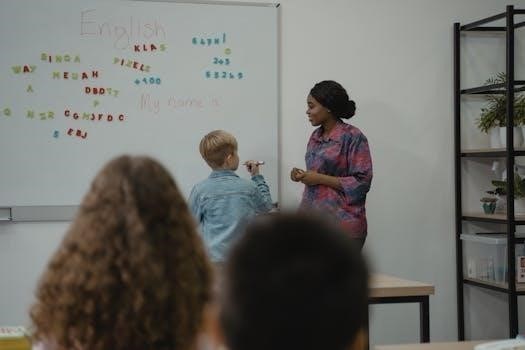year 3 english worksheets pdf
Year 3 English Worksheets PDF⁚ A Comprehensive Guide
This guide offers a comprehensive look at Year 3 English worksheets in PDF format, designed to align with the National Curriculum. These resources provide structured, engaging activities that enhance key English skills, fostering literacy development for children aged 7-8. The worksheets support diverse learning needs.
National Curriculum Alignment
The Year 3 English worksheets are meticulously designed to align with the National Curriculum for England, ensuring that children are learning material appropriate for their age group. These resources cover key aspects of the curriculum, including reading, writing, grammar, and spelling, providing a structured approach to learning. The worksheets integrate the specific learning objectives set out by the Department for Education, ensuring that children are exposed to the required concepts and skills. The alignment with the National Curriculum helps teachers and parents to monitor their children’s progress against national standards. Furthermore, these worksheets are created with consideration for the expectations of Ofsted and DfE, offering reliable, high-quality content that supports effective teaching and learning. The curriculum plans for the academic year are carefully considered, making sure that these resources seamlessly fit into the existing framework. This focus on curriculum alignment provides a consistent and cohesive learning experience for all Year 3 students, facilitating their development in literacy and language.
Key English Skills Covered
The Year 3 English worksheets comprehensively cover a range of essential English skills, focusing on building a strong foundation for future learning. These resources emphasize reading comprehension, encouraging children to understand and analyze different types of texts. Writing skills are developed through various activities, including sentence construction, paragraphing, and creative writing prompts. Grammar and punctuation are addressed systematically, with exercises that improve children’s understanding and usage of correct sentence structure and punctuation marks. Spelling is another critical area covered, providing activities designed to enhance children’s ability to spell correctly. Vocabulary development is also a key focus, with worksheets that introduce new words and reinforce their meanings through context. The worksheets are designed to provide opportunities for children to practice and revise these skills, ensuring that they can use them confidently; The activities are structured to provide a balanced approach to all areas of the English curriculum, and to foster a love of language in young learners. These key skills will help them in all subjects.
Types of Activities Included
The Year 3 English worksheets feature a diverse array of activities designed to cater to different learning styles and preferences. These include reading comprehension exercises, which use varied text types such as stories, poems, and non-fiction passages to enhance understanding and analytical skills. Grammar activities involve sentence construction, identifying parts of speech, and using correct tense, all presented in an engaging manner. Punctuation exercises focus on mastering commas, full stops, question marks, and exclamation points. Spelling practice is incorporated through a variety of methods, including word searches, fill-in-the-blanks, and identifying misspelled words. Vocabulary development is supported by exercises that encourage the use of new words within context and synonym/antonym matching. There are also creative writing prompts that allow children to express their thoughts and ideas freely. Other activities include sequencing sentences and paragraphs, proofreading tasks, and matching words to their definitions. The activities are carefully designed to be interactive, fun, and to promote active learning. Each worksheet is structured to reinforce learning objectives effectively, and to be engaging for young learners. These activities aim to make learning fun.
Grammar and Punctuation Focus

The Year 3 English worksheets place a significant emphasis on strengthening grammar and punctuation skills, recognizing their fundamental role in effective communication. The grammar focus includes identifying and correctly using different parts of speech, such as nouns, verbs, adjectives, and adverbs, within sentences. Worksheets provide exercises to help children understand subject-verb agreement, and to construct grammatically correct sentences using varied sentence structures. There is a strong focus on the use of tenses, including past, present, and future tenses, presented through interactive tasks. The punctuation section of the worksheets focuses on the proper use of essential punctuation marks, such as full stops, question marks, exclamation points, and commas in lists and simple sentences. The worksheets also include activities on using capital letters correctly at the start of sentences and for proper nouns. These exercises are designed to be progressive, building from simple identification tasks to more complex sentence construction and error correction. The goal is to equip students with a solid understanding of grammar and punctuation rules to enhance their writing and comprehension abilities. These skills will be crucial for their future academic journey. Each activity is designed to be engaging and educational.
Spelling Practice
The Year 3 English worksheets dedicated to spelling practice aim to solidify students’ understanding of common spelling rules and patterns through a variety of engaging activities. These worksheets introduce and reinforce age-appropriate spelling words that are aligned with the national curriculum, focusing on high-frequency words and those that are often challenging for young learners. The activities include tasks such as identifying misspelled words, completing words with missing letters, and writing words in context within sentences. There is a strong emphasis on exploring different spelling patterns, including digraphs, trigraphs, and common suffixes and prefixes. The worksheets also incorporate visual learning through word searches and picture-word matching exercises, which help students connect spellings with their meanings. Regular practice with these worksheets aids in improving accuracy and fluency in spelling. The worksheets often provide space for students to write words multiple times, helping to reinforce correct spelling through repetition. By focusing on these key areas, the resources aim to build strong spelling foundations, fostering confidence and competence in written communication. The exercises are presented in a fun and interactive way to keep the children engaged.

Vocabulary Development
The vocabulary development section of Year 3 English worksheets focuses on expanding children’s word knowledge through a range of engaging activities. These resources introduce new words that align with the national curriculum, emphasizing both common words and those that are more challenging for students at this age. The worksheets employ diverse methods for learning, including matching words to definitions, using words in context through fill-in-the-blank exercises, and creating sentences with newly learned vocabulary. They often incorporate visual aids, such as illustrations, to help students grasp the meanings of words. Word association and categorization activities help children to deepen their understanding of relationships between words. The worksheets promote active learning by encouraging children to explore synonyms, antonyms, and homonyms, thereby building a richer, more nuanced vocabulary. Furthermore, these worksheets frequently integrate vocabulary from various subject areas, enhancing cross-curricular learning. Interactive games and puzzles, such as word scrambles and crossword puzzles, are employed to reinforce new vocabulary in a fun and engaging way. Through consistent practice with these worksheets, children develop a strong vocabulary base, improving their reading comprehension and writing skills. The worksheets are designed to be accessible and enjoyable.
Reading Comprehension Exercises
Year 3 English worksheets include a variety of reading comprehension exercises designed to enhance children’s ability to understand and interpret written text. These exercises typically feature age-appropriate passages from different genres, including fiction and non-fiction, to expose children to a range of writing styles and subject matter. The passages are carefully chosen to match the reading level of Year 3 students, ensuring they are challenging yet accessible. Following each passage, there are several comprehension questions that assess the students’ understanding of the text. These questions can be multiple-choice, short answer, or true/false, encouraging children to think critically about the information presented. Some questions focus on identifying specific details, while others require students to infer meanings or draw conclusions from the text. Activities often involve sequencing events, identifying main characters, and understanding the plot of a story. Moreover, the exercises may include vocabulary-related questions, prompting children to define words or understand their meanings within the context of the passage. Reading comprehension exercises in these worksheets aim to improve students’ ability to analyze, summarize, and synthesize information, thereby improving their overall literacy skills. These exercises are structured to build confidence and a love for reading.

Writing Prompts and Tasks
Year 3 English worksheets feature various writing prompts and tasks designed to stimulate creativity and enhance writing skills. These prompts often encourage children to write in different genres, such as narratives, descriptions, recounts, and persuasive pieces. Tasks may include completing a story, writing diary entries, or crafting letters. The worksheets provide a structured approach to writing, often including planning templates and checklists to guide students through the writing process. The prompts are carefully designed to be engaging and relevant to the interests of children aged 7-8. For example, a prompt might ask students to write about their favorite animal or to describe a magical place they have imagined. These activities are intended to develop their ability to organize thoughts, use descriptive language, and construct coherent sentences and paragraphs. The tasks also encourage the use of correct grammar, punctuation, and spelling. Some tasks may focus on specific writing techniques, such as using adjectives effectively or incorporating dialogue into a story. The worksheets may also include model texts that serve as examples for students to follow. The aim of these writing prompts and tasks is to build confidence in writing and encourage students to express their ideas effectively in written form. They promote a positive attitude towards writing.
How Parents Can Support Learning

Parents play a crucial role in supporting their child’s learning journey with Year 3 English worksheets. Creating a conducive learning environment at home is essential. This includes providing a quiet space for completing worksheets and ensuring there are minimal distractions. Parents can actively engage with their child by discussing the worksheet activities, clarifying any doubts, and helping them understand the instructions. Encouraging regular reading habits is vital; parents should read with their child and discuss the stories to improve comprehension. Engaging in conversations about everyday experiences helps build vocabulary and improve communication skills. Parents can also assist with homework, ensuring it is completed accurately and on time, but without doing the work for them. Supporting literacy activities outside of worksheets, such as playing word games and encouraging creative writing, can further enhance their English skills. Making learning fun and enjoyable can motivate the child to learn more. Additionally, providing positive feedback and praising their efforts can build their confidence. Parents can also communicate regularly with teachers to understand areas where their child needs additional support. By working together, parents and teachers can create a holistic approach to learning, helping the child thrive in their English studies. Consistent encouragement from parents is key to success.
Recommended Resources for Year 3 English
To effectively support Year 3 English learning, various resources are highly recommended. Textbooks aligned with the National Curriculum provide a solid foundation for English studies, offering comprehensive coverage of key topics. Reading materials, including age-appropriate fiction and non-fiction books, are crucial for developing reading comprehension and vocabulary. Online learning platforms offer interactive exercises and games that engage children and reinforce their learning. These platforms often provide personalized learning experiences tailored to individual needs. Educational websites with free worksheets and activities can supplement classroom learning and provide extra practice opportunities. Workbooks focusing on specific skills, such as spelling, grammar, and punctuation, can offer targeted support. Dictionaries and thesauruses are essential tools for vocabulary development and improving writing skills. Libraries are a valuable resource for accessing a wide range of reading materials, including books and magazines; Furthermore, educational apps can make learning fun and accessible, providing engaging activities on mobile devices. Teachers often recommend specific resources based on the curriculum requirements and the child’s individual learning needs. Parents should also explore resources from reputable educational publishers that provide high-quality learning materials. Using a variety of resources can create a well-rounded learning experience and help children succeed in their Year 3 English studies. These resources should be used consistently to maximize their effectiveness.


